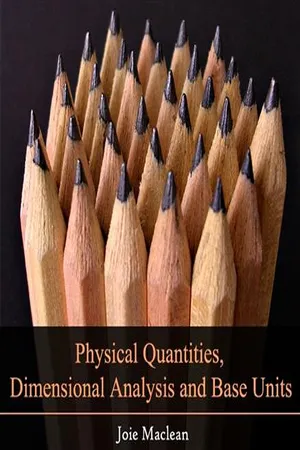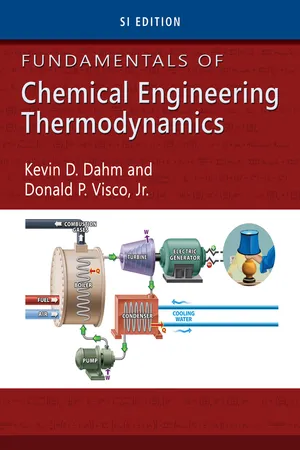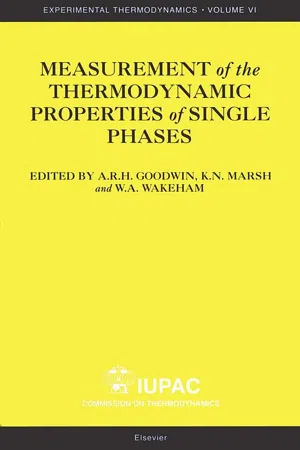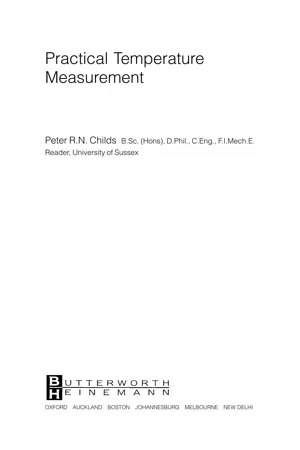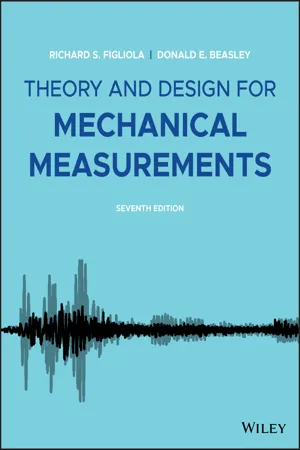Technology & Engineering
Absolute Temperature
Absolute temperature refers to a temperature scale that starts at absolute zero, the lowest possible temperature where molecular motion ceases. The most commonly used absolute temperature scale is the Kelvin scale, where 0 K represents absolute zero. Absolute temperature is important in engineering and technology for calculations involving gas laws, thermodynamics, and heat transfer.
Written by Perlego with AI-assistance
Related key terms
1 of 5
9 Key excerpts on "Absolute Temperature"
- No longer available |Learn more
- (Author)
- 2014(Publication Date)
- Learning Press(Publisher)
____________________ WORLD TECHNOLOGIES ____________________ Chapter- 5 Temperature The temperature of an ideal monatomic gas is related to the average kinetic energy of its atoms. In this animation, the size of helium atoms relative to their spacing is shown to scale under 1950 atmospheres of pressure. These atoms have a certain, average speed (slowed down here two trillion fold from room temperature). Temperature is a physical property that quantitatively expresses the common notions of hot and cold. Objects of low temperature are cold, while various degrees of higher temperatures are referred to as warm or hot. Temperature is measured with thermometers, which may be calibrated to a variety of temperature scales. Much of the world uses the Celsius scale for most temperature measurements. The Kelvin scale is the temperature standard for scientific or engineering purposes. It has the same incremental scaling as the Celsius scale, but fixes its origin, or null point, at absolute zero (0K = −273.15°C). Few countries, most notably the United States, use the Fahrenheit scale for common purposes, a historical scale on which water freezes at 32°F and boils at 212°F. A thermometer is essentially a device which measures its own temperature. If two systems are in thermal equilibrium, they have the same temperature, by definition. This means that bringing a thermometer into thermal contact with another system, and ____________________ WORLD TECHNOLOGIES ____________________ allowing equilibrium to occur, the temperature of the other system will be equal to that indicated by the thermometer. The second law of thermodynamics then defines Absolute Temperature through the use of the concept of reversible heat engines operating between systems at different temperatures, but only to within a calibration constant. This allows the actual construction of a thermometer. - No longer available |Learn more
- (Author)
- 2014(Publication Date)
- Academic Studio(Publisher)
it will have a higher heat capacity than a monatomic gas. ________________________ WORLD TECHNOLOGIES ________________________ The process of cooling involves removing thermal energy from a system. When no more energy can be removed, the system is at absolute zero, which cannot be achieved experi-mentally. Absolute zero is the null point of the thermodynamic temperature scale, also called Absolute Temperature. If it were possible to cool a system to absolute zero, all motion of the particles comprising matter would cease and they would be at complete rest in this classical sense. Microscopically in the description of quantum mechanics, however, matter still has zero-point energy even at absolute zero, because of the uncertainty principle. Absolute zero is defined as a temperature of precisely 0 kelvins, which is equal to −273.15 °C or −459.68 °F. Use in science A map of global long term monthly average surface air temperatures in Mollweide projection. Temperature plays an important role in all fields of natural science, including physics, geology, chemistry, atmospheric sciences and biology. Many physical properties of materials including the phase (solid, liquid, gaseous or plasma), density, solubility, vapor pressure, and electrical conductivity depend on the temperature. Temperature also plays an important role in determining the rate and extent to which chemical reactions occur. This is one reason why the human body has several elaborate mechanisms for maintaining the temperature at 310 K, since temperatures only a few degrees higher can result in harmful reactions with serious consequences. Tem-perature also controls the thermal radiation emitted from a surface. One application of this effect is the incandescent light bulb, in which a tungsten filament is electrically heated to a temperature at which significant quantities of visible light are emitted. - Kevin Dahm, Donald Visco(Authors)
- 2014(Publication Date)
- Cengage Learning EMEA(Publisher)
Editorial review has deemed that any suppressed content does not materially affect the overall learning experience. Cengage Learning reserves the right to remove additional content at any time if subsequent rights restrictions require it. 37 C H A P T E R 1 Introduction The concept of an Absolute Temperature has broad utility in chemical engineer-ing thermodynamics. The ideal gas law, discussed in Section 2.3.3, relates tempera-ture, pressure and molar volume to each other, but requires that all three quantities ( T, P, and V ) are measured on an absolute scale. Many additional thermodynamics properties (e.g., entropy, Gibbs energy) developed later in this book also depend upon an Absolute Temperature. A simple point, but one that often causes confusion, is addressed in the following example. EXAMPLE 1‑8 A CHANGE IN TEMPERATURE On a stove, water is heated from room temperature T 5 25 ° C to boiling temperature T 5 100 ° C. Determine Δ T in degrees Celsius and in degrees Kelvin. SOLUTION: In Celsius: D T 5 T final 2 T initial 5 100 2 25 8 C 5 75 8 C (1.41) In Kelvin: D T 5 T final 2 T initial 5 s 100 1 273.15 K d 2 s 25 1 273.15 K d (1.42) 5 75 K As mentioned above, in many thermodynamics applications, temperature ( T ) must be expressed on an absolute scale. A danger is becoming so accustomed to adding 273.15 to any Celsius temperature that one carelessly does so for a change in temperature. For example “the water temperature increased by 75°C,” does not con-vert to “the water temperature increased by 348.15 K.” Example 1-8 illustrates that a change in temperature (Δ T ) is identical on the Celsius and Kelvin scales, because the conversion factor cancels. A similar demonstration could be made for the Fahrenheit and Rankine scales. 1.4.9 Overview of the Forms of Energy Conceptually, the crucial points in this section include: Work occurs because of an imbalance in force, and is recognizable when motion occurs against an opposing force.- Anthony Goodwin, KN Marsh, WA Wakeham(Authors)
- 2003(Publication Date)
- Elsevier Science(Publisher)
2Temperature
J.V. Nicholas; D.R. White Measurement Standards Laboratory of New Zealand Industrial Research Lower Hutt, New ZealandThe measurement of temperature is fundamental to thermodynamic measurements and, since publication of Experimental Thermodynamics Volume II , the temperature scale has been updated from the International Practical Temperature Scale of 1968 (IPTS-68) to the International Temperature Scale of 1990 (ITS-90). This chapter covers the implementation of ITS-90 and recent determinations of the fundamental fixed points, which are essential to the practical determination of temperature using secondary thermometers. In addition, the temperature scale at T < 1 K and T > 2000 K are discussed. The use of primary acoustic thermometry for the establishment of the fixed-point temperatures is described in Chapter 6 .2.1 Thermodynamic Origin of Temperature
The scientific meaning for temperature is at the heart of thermodynamics. It arises from the Zeroth Law of thermodynamics that states that if two systems are in thermal equilibrium and one of those systems is in thermal equilibrium with a third system, then all three systems are in thermal equilibrium with each other. Thus, temperature is the property of a system that conveys information about the thermal equilibrium of the system. The Zeroth Law only establishes equality of temperatures and permits the use of any single valued function as an empirical temperature scale. In order to establish a metric scale for temperature, one that allows meaningful ratios of temperature, the Second Law of thermodynamics is used to define an Absolute Temperature, T , by expressing the law asd S ≥ δ Q / T(2.1)where dS is the change in entropy and δQ is the change in heat. There are other thermodynamically equivalent ways of defining the temperature scale as described in, for example, reference [1]- eBook - PDF
- Peter Childs, Peter R. N. Childs(Authors)
- 2001(Publication Date)
- Butterworth-Heinemann(Publisher)
Quinn (1990) Temperature 3 The definition given in equation (1.1) can appear abstract and for many applications the notion of temperature as a measure of hotness and temperature difference as a potential for the transfer of heat energy from one region to another is quite adequate. Nevertheless a quantitative definition of temperature is the basis of a substantial proportion of science, and it is a necessity for some temperature measurement applications, particularly those where temperatures are low or varying rapidly. 1.2 Temperature scales In order to provide meaningful comparisons of temperature measurements made by different people it is useful to define a common scale. The definition of temperature scales is an arbitrary undertaking. One approach, referred to as the thermodynamic temperature scale, provides a linear scale that is valid for any substance and temperature range. The thermodynamic temperature scale is based on the ideal reversible Carnot engine cycle. The Carnot cycle consists of isothermal heat transfer at a high temperature, adiabatic expansion, isothermal heat transfer at a low temperature and adiabatic compression back to the high temperature. The Carnot engine efficiency is given by = 1 – T 2 T 1 (1.2) where: = efficiency, T 1 = the high value of temperature at which isothermal heat transfer takes place in the cycle, T 2 = the low value of temperature at which isothermal heat transfer takes place in the cycle. Examination of equation (1.2) provides some insight into the concept of temperature and defines some bounds. Efficiency can never be greater than unity otherwise one would obtain more work out of a system than put in; a gross violation of the laws of physics. Efficiency equal to unity can only be achieved theoretically if T 2 is equal to zero or as T 1 approaches infinity. T 2 equal to zero therefore defines the lowest possible theoretical limit for temperature. - Richard S. Figliola, Donald E. Beasley(Authors)
- 2019(Publication Date)
- Wiley(Publisher)
Suggested Reading 313 S U M M A R Y Temperature is a fundamentally important quantity in science and engineering, both in concept and practice. Thus, temperature is one of the most widely measured engineering variables, providing the basis for a variety of control and safety systems. This chapter provides the basis for the selection and installation of temperature sensors. Temperature is defined for practical purposes through the estab- lishment of a temperature scale, such as the Kelvin scale, that encompasses fixed reference points and interpolation standards. The International Temperature Scale 1990 is the accepted standard for temperature measurement. The two most common methods of temperature measurement use thermocouples and RTDs. Standards for the construction and use of these temperature measuring devices have been established and provide the basis for selection and installation of commercially available sensors and measuring systems. Installation effects on the accuracy of temperature measure- ments are a direct result of the influence of radiation, conduc- tion, and convection heat transfer on the equilibrium temperature of a temperature sensor. The installation of a temperature probe into a measuring environment can be accomplished in such a way as to minimize the uncertainty in the resulting temperature measurement. R E F E R E N C E S 1. Patterson, E. C., Eponyms: Why Celsius? American Scientist 77(4): 413, 1989. 2. Klein, H. A., The Science of Measurement: A Historical Survey, Dover, Mineola, NY, 1988. 3. Committee Report, the International Temperature Scale of 1990, 4 Metrologia 27(1): 3–10, 1990. (An Erratum appears in Metrologia 27(2): 107, 1990.) 4. Temperature Measurement, Supplement to American Society of Mechanical Engineers PTC 19.3, 1974. 5. Diehl, W., Thin-film PRTD, Measurements and Control, 155–159, December 1982.- eBook - PDF
Engineering Fundamentals
An Introduction to Engineering, SI Edition
- Saeed Moaveni(Author)
- 2019(Publication Date)
- Cengage Learning EMEA(Publisher)
Cengage Learning reserves the right to remove additional content at any time if subsequent rights restrictions require it. CHAPTER 11 Temperature and Temperature-Related Variables in Engineering 372 Regardless of which engineering discipline you are planning to pursue, you need to develop a good understanding of what is meant by temperature and how it is quantified. Figure 11.1 illustrates some of the systems for which this understanding is important. Electronic and computer engineers, when design- ing computers, televisions, or any electronic equipment, are concerned with keeping the temperature of various electronic components at a reasonable operating level so that the electronic components will function properly. In fact, they use heat sinks (fins) and fans to cool the electronic chips. Civil engineers need to have a good understanding of temperature when they design pavement, bridges, and other structures. They must design the structures in such a way as dibrova/Shutterstock.com imagedb.com/Shutterstock.com Viacheslav Lopatin/Shutterstock.com Tyler Olson/Shutterstock.com F I G U R E 1 1 . 1 Examples of engineering systems for which an understanding of temperature and heat transfer is important. Copyright 2020 Cengage Learning. All Rights Reserved. May not be copied, scanned, or duplicated, in whole or in part. Due to electronic rights, some third party content may be suppressed from the eBook and/or eChapter(s). Editorial review has deemed that any suppressed content does not materially affect the overall learning experience. Cengage Learning reserves the right to remove additional content at any time if subsequent rights restrictions require it. 11.1 Temperature as a Fundamental Dimension 373 to allow for expansion and contraction of materials, such as concrete and steel, that occur due to changes in the surrounding temperatures. - eBook - PDF
- Arthur Scott(Author)
- 2012(Publication Date)
- Academic Press(Publisher)
The scale defined in the first line of this table is the one universally known as the absolute, or Kelvin, scale. That in the second line is of interest in connection with negative Kelvin temperature (see Appendix B). That in the third line is of interest in connection with the history of the Absolute Temperature concept, a subject we shall not pursue here. 208 FREDERICK O. KOENIG TABLE I THREE Absolute Temperature SCALES Ψ( T) Significant range of Ψ( T) Corresponding range of T T 0<Ψ(Γ)<οο 0 < Γ < ο ο -l/T 0<Ψ(Γ)<οο -ο ο < Γ < 0 e T 0 < Ψ(Τ) <οο -οο < Γ < οο By virtue of Eq. (3.10.24) it follows from Eqs. (3.10.21) and (3.10.23) that for any absolute scale 92/βι = -[Ψ(Γ2)/Ψ(Γι)] (3.10.25) 0 < Ψ(Τ 2 )/Ψ(Τ 1 ) < 1 (3.10.26) But we note for clarity that although subscript 2 refers throughout to the lower —in the general sense of Section 2.14—of the two temperatures involved, so that for the empirical temperatures we always have θ 2 <θ ί as already said, for the Absolute Temperatures the analogous condition T 2 T v We note further that the foregoing definitions do not suffice to determine for any given temperature in the general sense of Section 2.14, a numerical value of T on any (absolute) scale. Or in other words, they leave undefined the unit of T. This is a consequence of the multiplicative indeterminateness of φ(θ) already pointed out The unit of T on any (absolute) scale can always be defined by assigning an arbitrary value of T to some fixed point (defined in Section 2.14). To show this we denote this arbitrary value by T* 9 and then consider a Carnot engine operating between the chosen fixed point and any other temperature (above or below the fixed point) whatever. - eBook - PDF
- John D. Cutnell, Kenneth W. Johnson, David Young, Shane Stadler(Authors)
- 2015(Publication Date)
- Wiley(Publisher)
Such a situation would be impossible, because a negative absolute gas pressure has no meaning. Thus, the Kelvin scale is chosen so that its zero temperature point is the lowest temperature attainable. 12.3 | Thermometers All thermometers make use of the change in some physical property with temperature. A property that changes with temperature is called a thermometric property. For example, the thermometric property of the mercury thermometer is the length of the mercury col- umn, while in the constant-volume gas thermometer it is the pressure of the gas. Several other important thermometers and their thermometric properties will now be discussed. The thermocouple is a thermometer used extensively in scientific laboratories. It con- sists of thin wires of different metals, welded together at the ends to form two junctions, as Figure 12.5 illustrates. Often the metals are copper and constantan (a copper–nickel alloy). One of the junctions, called the “hot” junction, is placed in thermal contact with the object whose temperature is being measured. The other junction, termed the “reference” junction, is kept at a known constant temperature (usually an ice–water mixture at 0 8C). The ther- mocouple generates a voltage that depends on the difference in temperature between the two junctions. This voltage is the thermometric property and is measured by a voltmeter, as the drawing indicates. With the aid of calibration tables, the temperature of the hot junction Kelvin, K Celsius, °C Steam point Ice point Absolute zero One kelvin equals one Celsius degree 0 – 273.15 0.00 273.15 100.00 373.15 Figure 12.2 A comparison of the Kelvin and Celsius temperature scales. Gas-filled bulb Evacuated space Reference level U-tube manometer Substance whose temperature is being measured h Mercury Figure 12.3 A constant-volume gas thermometer.
Index pages curate the most relevant extracts from our library of academic textbooks. They’ve been created using an in-house natural language model (NLM), each adding context and meaning to key research topics.
